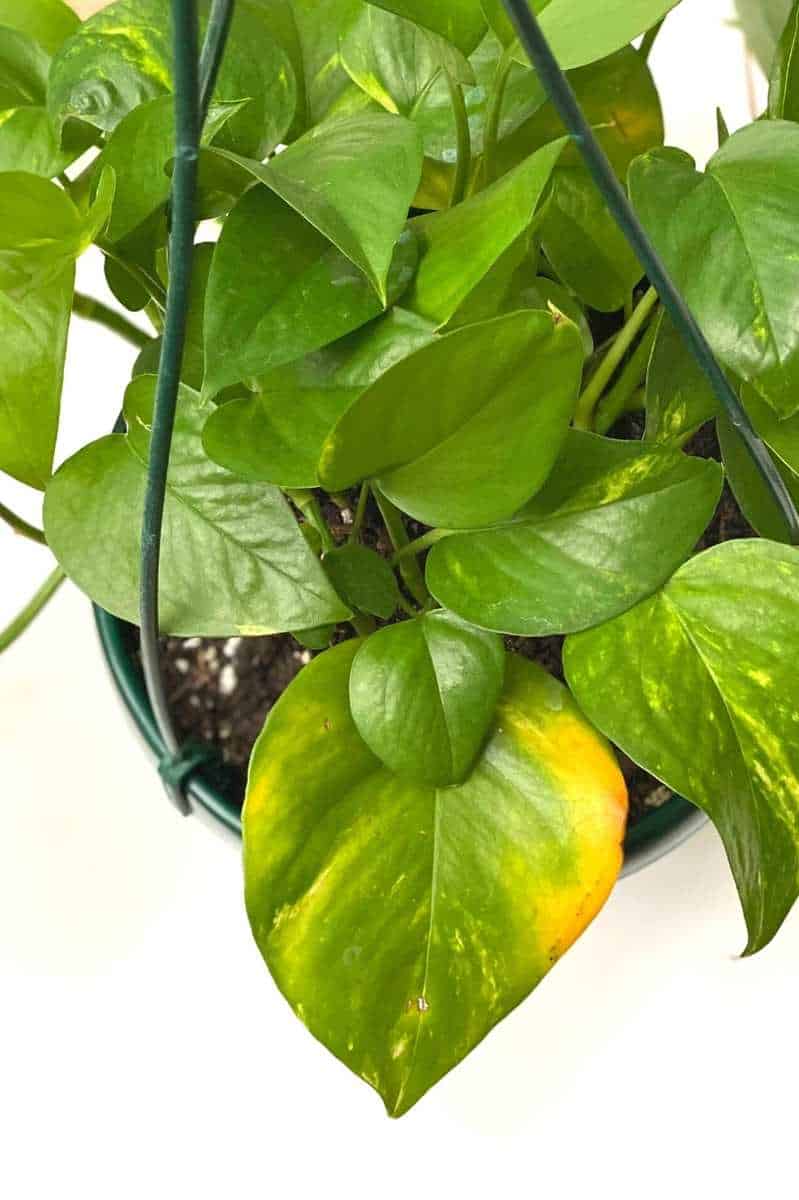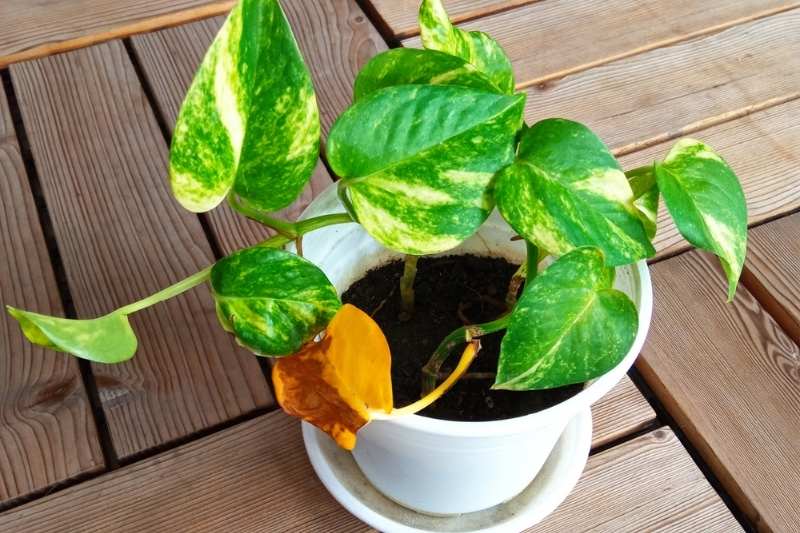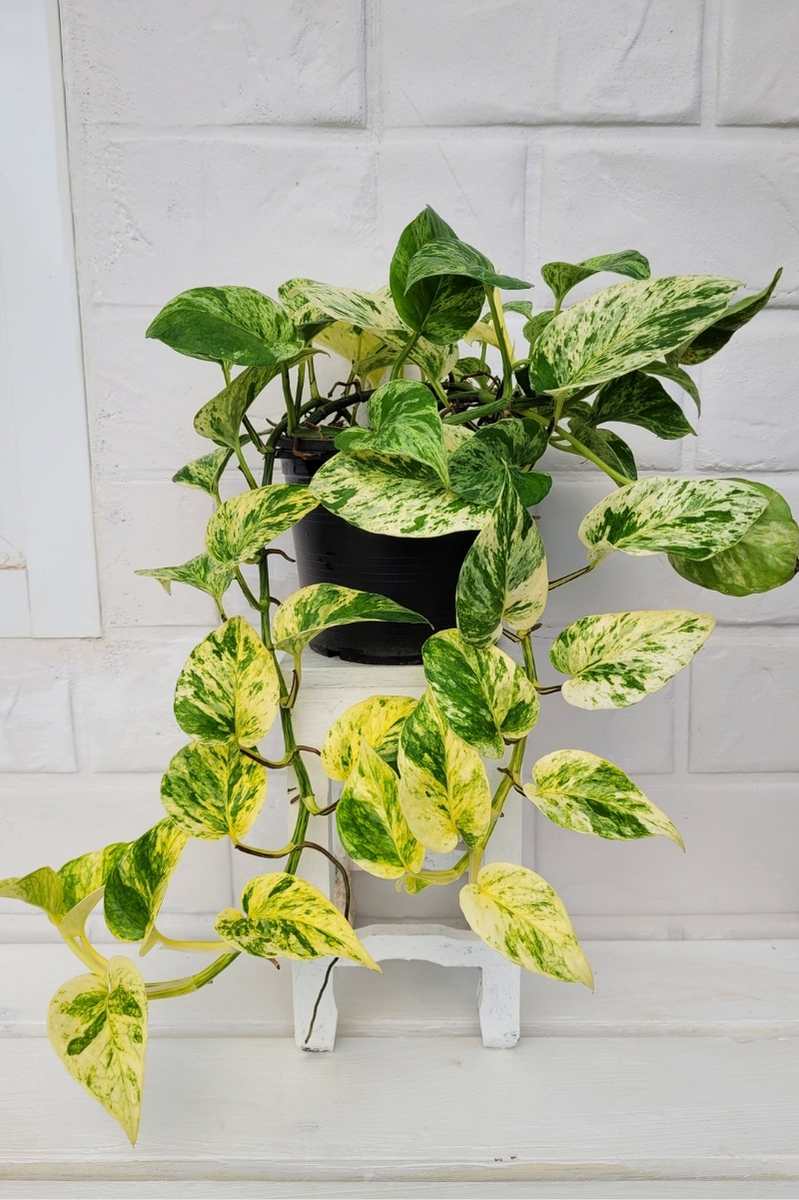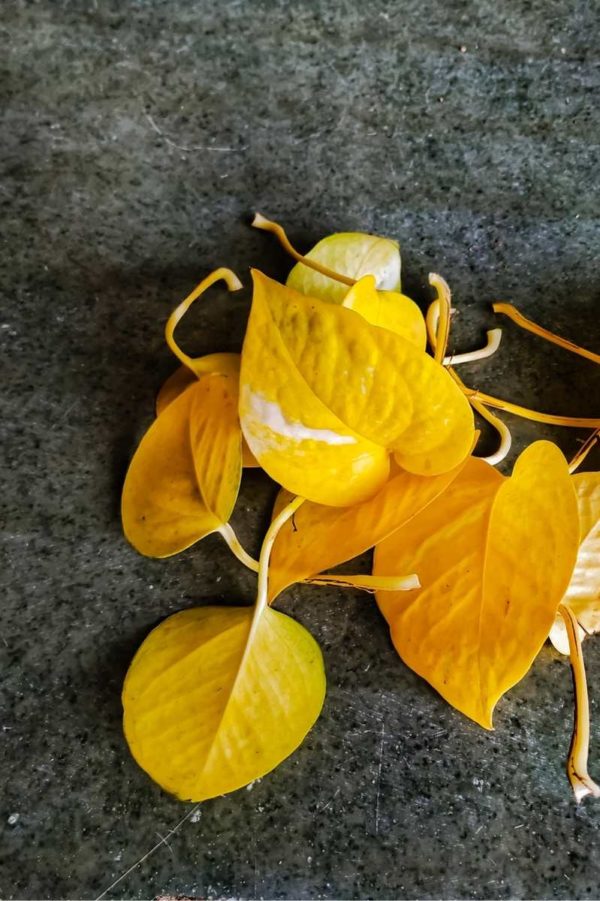Pothos, or epipremnum aureum, tend to show up on every “indoor plants for beginners” list, thanks to their hardy nature and low maintenance vibes. But that doesn’t mean that they are completely immune to problems—pothos plants can suffer from overwatering, underwatering, root rot, and diseases just like any other houseplant.
One of the first signs that something is amiss with a pothos is when the leaves start to turn yellow. Luckily, if you catch the yellowing early on, you can save your plant and get it back to its vibrant, healthy self. Let’s dive in.

Table of Contents
Can yellow pothos leaves turn green again?
In most cases, once a leaf turns yellow, it isn’t going to turn back to its green or variegated color. But we can help your pothos thrive so that it is putting out new, healthy growth soon!
Should I remove yellow leaves from pothos?
If the leaves are yellowing because of age, improper watering, or a nutrient deficiency, you may want to leave them on the plant until they are fully yellow all the way through. This gives the plant a chance to recover some of the nitrogen, phosphorus, potassium, and other essential nutrients from the leaves (source). However, if you really don’t like the look of them, you can also clip them off the plant.

Aging Leaves
Before we dig into troubleshooting your pothos plant, let’s establish whether or not there is actually a problem. Sometimes, the older leaves on the pothos will turn yellow and eventually die off just as a natural part of the plant aging. If your pothos is still putting out new foliage and seems otherwise healthy, and only one or two leaves are turning yellow at a time, then it may be that you’re just seeing the natural process that every plant goes through.
If you suspect that the yellowing leaves are just reaching the end of their natural life span, you don’t need to do much. Apply a diluted houseplant fertilizer to boost the nutrients of the soil, and keep an eye on your pothos plant to make sure the yellowing isn’t an early sign of another problem.
Underwatering
General advice for pothos is to “water when the soil is dry,” but this can be a bit difficult to gauge. Luckily, pothos are good communicators about their needs—when your pothos needs water, the vines and leaves will look droopy and a bit limp. Once you give your plant a good drink, your pothos should look perky and bouncy again.
If the yellow leaves are also looking crispy, your pothos may be underwatered. Aerate the soil by gently poking it with something like a wooden chopstick, and slowly pour water over the entire surface of the soil until you see water coming out of the pot’s drainage hole. Moving forward, make sure to watch for dry soil and droopy vines to cue you on when you water.
If there is a watering issue with pothos though, it is much more likely to be overwatering or inconsistent watering than it is to be underwatering. So let’s dive into that.
Overwatering
If the yellow leaves on your pothos are also wilting or starting to show brown spots, your pothos may be overwatered. When excess water sits in the soil for too long, the roots can’t get the oxygen that they need to thrive and stay healthy, which can lead to yellowing leaves.
If you suspect that overwatering is the culprit, you can reverse the damage. First, clip off the yellow leaves. You can fix the overwatering problem, but these leaves aren’t going to turn back to green or variegated and thriving. Then, do one or a combination of the following:
- Move your pothos to a sunnier spot. It may be that the soil is taking too long to dry out, and if your plant gets more light exposure, it will use up the soil moisture more quickly, and the roots won’t be sitting in soggy soil for prolonged periods of time.
- Correct for poor drainage. If you want to keep your plant in a lower light situation such as an office, you’ll want to be sure that the potting medium is well-draining. If your soil drains slowly or seems to hold on to moisture for a long time, you may want to mix in some perlite, coco coir, or coarse sand. The pot should also have drainage holes to allow excess water to run out of the soil.
Moving forward, wait to water your pothos until the soil is dry and the stems are looking droopy.

Improper Watering
Pothos leaves turning yellow is a sign that the plant is experiencing some sort of stress, and it is possible that the problem isn’t overwatering or underwater, but inconsistent watering. If the soil is regularly cycling between too dry and oversaturated/slowly draining, it could be the source of your pothos’s health problems. Here is a proper watering method that will keep the pothos happy and its roots healthy:
- Watch for early signs that your pothos is getting thirsty. Press your finger into the soil: does it feel dry? Are the vines looking a bit droopy instead of bouncy and curling upwards? It’s time to water!
- Aerate the soil. Gently poke the soil with a chopstick or skewer, being careful not to stab the roots. This will let air and water circulate all around the roots.
- Slowly pour room temperature water all around the surface of the soil, until you see water running out of the drainage hole.
- Return your pothos to a spot where it gets plenty of light. If this isn’t possible, then make sure your pot has good drainage and that your potting medium is well-draining. The goal is to make sure that the roots aren’t soggy for long periods of time.
Root Bound
It is also possible that your pothos has outgrown its current planter and has become root bound, which can also lead to pothos leaves turning yellow. If your pothos is showing slowed or stunted growth, you see the roots poking out from the drainage holes, or the plant seems to be running out of space, it may be that the plant needs to be repotted.
Gently tip the pothos out of its pot, being sure to support the bottom of the plant with your hand, to look at the root ball. If the roots look dense and wrapped in the shape of the pot, it is time for some repotting!
Root Rot
Root rot is caused by pathogens like pythium or fusarium, which thrive in waterlogged soil. When lots of pothos leaves turn yellow and the stems are mushy, inspect the roots. Remove the pothos from its pot, making sure to support the base of the plant, and look at the root ball. If the roots are mushy, soft, and black, root rot has taken hold.
If any of the roots still appear pale and firm, the pothos can probably still be saved:
- Gently rinse the roots under lukewarm water, removing as much soil as possible.
- Use a sharp pair of shears to remove all of the rotted roots, and dispose of the old potting soil. Rotten roots are mushy and soft, while healthy roots will still feel nice and firm.
- Wash the pot with a diluted bleach solution to kill any remaining pathogens.
- Repot the pothos in fresh, well-draining potting mix—if you’ve cut off a significant portion of the roots, you may need to size down your pot. You may want to dip the roots in a fungicide before replanting.
- Clean the shears with rubbing alcohol and prune back any affected leaves, as well as additional leaves proportional to the amount of roots you cut back. This way, the remaining healthy roots won’t be overly taxed from trying to support so many extra leaves.
There are other fungal diseases that can infect pothos, but they are all much less likely to be the culprit than root rot.

Bacterial Leaf Spot
If the yellowing appears as halos around soft, watery, mushy spots on the leaves, you may be looking at a case of bacterial leaf spot. Remove all the infected leaves and petioles (the parts that connect leaves to the stems), and consider treating with a bactericide. Moving forward, make sure you are pouring water directly on the soil, rather than getting the leaves wet.
Pests
Though pothos plants are relatively hardy, they are not immune from a pest infestation. Mealybugs appear as white fuzzy spots in the nooks and crannies of the plant, and can be removed with a cotton swab dipped in rubbing alcohol.
Spider mites look like tiny spiders, and while they can be difficult to detect, the white webbing they leave behind is easy to identify. Isolate the pothos from other plants, and spray down the plant with water to knock off the mites. Treat with an insecticidal soap or neem oil.
By now, you’ve hopefully been able to diagnose why your pothos leaves are turning yellow and how to stop it. Happy growing!








What if they started turning yellow after repotting? I had 3 small pathos plants that lived happily in small terracotta pots for a couple of years. They got to big, but instead of growing compact and bushy, they each had one long vine with lots of leaves. So, I decided to replant them together in one much larger pot to give the appearance of a larger, bushier plant. They looked fine at first but within a couple of weeks, they each have developed yellow leaves.
Is this just due to the shock of repotting? Or could it be another problem? Should I have not planted them together?
It could just be shock. Make sure they are getting watered properly and that the pot isn’t TOO large. They like being a little crowded!
Very helpful and well-written!! Thank you so much..
This article is quite helpful and well-written. It covers every element of
My pothos is traversing my ceiling. The edges of the lowest leaves are turning brown
How to repot this monster?
[email protected]
We talk all about repotting here: https://growfully.com/how-to-repot-a-plant/